#Flexible grid systems
Explore tagged Tumblr posts
Text
#solar energy panels#photovoltaic panel#solar power system#renewable energy panel#solar panel efficiency#off-grid solar solution#monocrystalline solar panel#polycrystalline solar panel#bifacial solar panel#solar panel wattage#solar panel pricing#best solar panels#home solar installation#commercial solar panels#solar energy storage#solar panel inverter#solar battery backup#portable solar panels#flexible solar panel#solar panel degradation#DIY solar installation#solar panel rebate#solar panel incentives#solar panel maintenance#solar panel cleaning#solar panel durability#solar panel lifespan#solar power for RVs#residential solar financing#solar panel weight
0 notes
Text
APAC Is Dominating Vanadium Redox Flow Batteries Market
In 2023, the market for vanadium redox flow batteries witnessed an approximate revenue of USD 401.2 million. Projected into the forecast period from 2024 to 2030, the market is anticipated to exhibit a Compound Annual Growth Rate (CAGR) of 9.7%, ultimately reaching a valuation of USD 759.4 million by the end of 2030. UPS systems are becoming a vital component of offices, homes, sectors, and all…
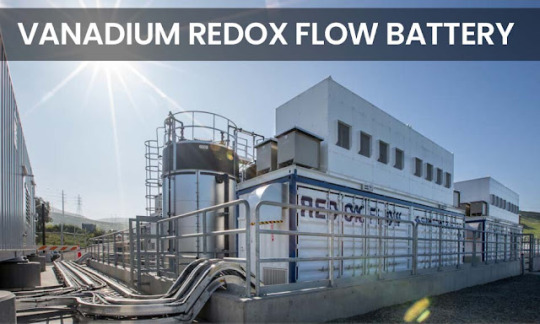
View On WordPress
#applications#battery technology#clean energy systems#electric vehicle charging infrastructure#flexibility#grid stabilization#Growth opportunities#Key players#Market dynamics#market trends#Redox flow batteries#renewable energy storage#scalability#strategic collaborations
0 notes
Text
Harnessing Energy Transformation: Exploring the Power-to-Gas Market Potential

Power-to-Gas Market
The Power-to-Gas Market is at the forefront of the energy transition, offering a transformative solution for storing and utilizing surplus renewable energy. As the world pivots toward sustainable energy systems, Power-to-Gas technology is emerging as a game-changer in the pursuit of a cleaner and more resilient energy landscape.
Power-to-Gas: A Paradigm Shift in Energy Storage
The Power-to-Gas Market revolves around a cutting-edge concept: converting surplus electricity from renewable sources, such as wind and solar, into chemical energy carriers like hydrogen or methane. This innovative technology addresses one of the most critical challenges of renewable energy integration - the intermittency of sources like wind and solar. By storing excess energy during peak production periods and converting it back to electricity or heat when needed, Power-to-Gas bridges the gap between supply and demand.
Market Dynamics and Diverse Applications
The Power-To-Gas Market dynamics are rooted in its diverse applications across different sectors. One of its primary applications is in energy storage. Excess renewable energy can be converted into hydrogen through electrolysis, which can then be stored for future use. Additionally, hydrogen produced through Power-to-Gas can serve as a clean fuel for various industries, including transportation, industry, and heating.
Advancing Renewable Integration and Decarbonization
As the world accelerates its transition towards renewable energy, the Power-to-Gas technology is playing a pivotal role in realizing this vision. It acts as a buffer, ensuring that surplus energy isn't wasted and enabling the grid to handle fluctuations in renewable energy generation. Moreover, Power-to-Gas contributes to decarbonization efforts by producing clean hydrogen, which can replace fossil fuels in industrial processes and transportation.
Overcoming Challenges and Scaling Up
While the potential of Power-to-Gas is immense, the Power-To-Gas Market isn't without its challenges. The cost of producing hydrogen through electrolysis and the limited availability of infrastructure are areas that require attention. However, ongoing research and development are gradually driving down costs and paving the way for broader adoption. Government incentives and policy support are also crucial in accelerating market growth and creating an enabling environment for Power-to-Gas technologies.
Future Outlook: Transforming the Energy Landscape
The Power-to-Gas Market's future outlook is marked by optimism and innovation. As the world strives to achieve ambitious climate goals, the demand for flexible energy storage solutions will only increase. Power-to-Gas not only addresses energy storage challenges but also aligns with the broader goal of creating integrated energy systems that are cleaner, more resilient, and capable of accommodating the dynamic nature of renewable energy sources.
In conclusion, the Power-to-Gas Market embodies the essence of the energy transition - a shift toward sustainable, flexible, and decarbonized energy systems. As technology advances, costs decrease, and policies evolve, Power-to-Gas has the potential to revolutionize the way we store and utilize energy, paving the way for a greener and more sustainable future.
#Power-to-Gas Market#energy transition#renewable integration#energy storage solutions#electrolysis technology#hydrogen production#decarbonization efforts#renewable energy systems#grid flexibility#sustainable energy#policy support#market challenges#innovative technologies#climate goals
0 notes
Text
"It’s technically possible for the UK to achieve its goal of having a clean power system by 2030, and doing so should reduce electricity bills and bolster the country’s energy security, the grid operator says in a study commissioned by the new Labour government.
The context
The UK recently shut its last coal-fired power plant and aims to slash its use of gas turbines as it seeks to all but eliminate fossil fuels from its electricity mix by the end of the decade.
In 2023, renewables and nuclear accounted for 62% of the country’s electrical output, while fossil fuels held a 38% share. Under the 2030 clean power target, fossil fuels (gas) would be reduced to less than 5% of the mix.
The latest
“The analysis concludes that clean power is a huge challenge but is achievable for Great Britain by 2030,” the National Energy System Operator said in a statement as it published the study.
Overall system costs are unlikely to increase if the target is met, and tariffs could in fact decline as legacy power contracts expire and if the state makes sufficient progress on energy efficiency gains, flexibility mechanisms, improving grid connection processes, and overall policy modernisation.
Significant investments are required in a short amount of time, but they would allow the UK to become a “leader” in new technologies while also reducing the country’s exposure to potential energy price shocks stemming from spikes in international gas prices, as was the case after Russia invaded Ukraine.
NESO’s analysis shows that clean technologies — renewables and nuclear — will be able to produce at least as much power as Great Britain consumes in total in 2030...
“A clean power system for Great Britain will deliver a backbone of home-grown energy that breaks the link between volatile international gas prices; that is secure and affordably powers our homes and buildings; that decarbonises the transport that we take to school and work; that drives the businesses of today and catalyses the innovations of the future.”
Next steps: The government will now consider NESO’s advice as it develops its clean power action plan later this year."
-via The Progress Playbook, November 5, 2024
#uk#united kingdom#clean energy#renewables#wind power#solar power#fossil fuels#decarbonization#europe#good news#hope
398 notes
·
View notes
Text
What To Expect From 2025
Hello my friends, it's been a while. Sorry for the lack of posting, decided to take a break along with the drivers during our off-season, but as the weeks creep closer and anticipation grows, we must start to rev up for the first day of testing. As such, i wanted to do a little deep dive into what changes or special things to look forward to in this upcoming F1 season.
Some New Regulations
Heavier Cars: Starting 2025 the minimum weight for F1 cars will be around 2 kg heavier than they were in the previous season. This regulation change comes with another regulation change, one that has to do with driver wight. The old rule used to be that drivers must be at minimum 80 kgs, and has been switched to 82 out of concern for taller drivers (and probably also due to the fact that the average height for drivers has gone up considerably in the past few years). While this may seem like a small thing, it has impacts because drivers who were previously encouraged to hit that low weight so they could be faster will have a little bit less pressure.
Flex-Wing Restrictions: Does anyone remember the 'mini-DRS' that McLaren had for the 2024 season? Yes, the little flexible wing that allowed them to gain massive amounts of speed in the straights has been officially declared illegal. The new regulation states that the minimum gap in the rear wing will be decreased from 10-15mm to 9.4-13mm. I am very curious to see how this effects the performance of the McLaren car come the first race, it was quite clear that the team lost their dominant momentum once they got rid of it last year.
Driver Cooling Systems: Good news for everyone who felt concern during any of the wildly hot races that had drivers vomiting in the past few years, a new regulation has passed that states that a driver cooling system must be in place temperatures go over 30.5 degrees celsius. It will be interesting to see how well this helps (hopefully a lot).
No More Fastest Lap Point: A sad day for anyone who enjoyed seeing drivers push their cars to the limits. The fastest lap point is officially gone, which means we might see drivers keep it calm toward the end of races now.
Setting the Grid: This one is interesting, and is most likely due to what happened in Brazil 2024. Anyone who watched all of that live remembers the worry you felt watching the drivers qualify that Sunday morning in terrible conditions, and this new regulation could prevent that. It states that if a qualifying to set the grid is impossible, the starting will be determined by championship standings. If it is too early in the season, it will be up to the stewards to decide how it sets (whatever that means).
"Driver Behavior": I am sure everyone has heard of this one, and I will not dive too deeply into all the ins and outs. Just know that drivers are pretty much flat out not allowed to curse, make political statements, yell, express frustration, or getting anywhere close to any sort of 'bad misconduct' without incurring massive fines, or suspensions, or even a docking of championship points. We will see how this one goes when the season starts.
Some New Team Dynamics
One thing to look forward to is the massive shift the entire grid has done. Only two teams retained both of their drivers, McLaren (Piastri and Norris) and Aston Martin (Alonso and Stroll), and we have rookies on top of rookies to go along with that. Really tells you how much of F1 is musical chairs in truth.

Hamilton and Leclerc with Ferrari:
A dynamic that is bound to be interesting. When two number one drivers are on one team it tends to make sparks fly, but perhaps that won't be the case with these two. Both are rather mature people and drivers, and for the past two years Hamilton has played second driver to Russell after all. So I think honestly there may be some moments on track, but they will work well together.

2. Ocon and Bearman with Haas:
This one will also be interesting, in my grand opinion. On Ocon's side, he has switched over to Haas after years with Alpine (not so great years at that), and now he is the senior driver for the first time ever. For Bearman, everyone knows how well he can race an F1 car, so I wonder how Ocon will react to being second fiddle (to a rookie this time), which no doubt be will be.

3. Bortoleto and Hulkenberg with Sauber:
This one I feel like will go really well. Hulkenberg knows how to be a team player, and is generally a nice guy. On top of that he has many years of experience, and will be a great asset to help build his rookie teammate up. For Bortoleto's part, he is an extreme talent who just came off winning the 2024 F2 season. I think in truth Sauber has one of the best line-ups of the midfielders.

4. Lawson and Verstappen with Red Bull:
Lawson will either be chewed up and spit out by Verstappen, or wholeheartedly ignored. Verstappen is very obviously the first driver, completely undisputed, and apparently Lawson has agreed to that. But how many times have we seen a hungry rookie ignore that fact? *cough cough* Charles Leclerc *cough cough*. All I do know if taht both drivers have a rather aggressive style on and off track, which usually doesn't lend itself to being teammates.

5. Hadjar and Tsunoda with RB:
This one I feel like will be kind of meh. Tsunoda will most likely outscore his teammate, and he has done for the past years, and it will be typical RB things. Hadjar is talented, but Tsunoda is too. The question will be who wants it more.

6. Doohan and Gasly with Alpine:
Another meh one, the only real drama stemming from the fact that Doohan might be an F1 car for a blink of an eye. Alpine has their eyes set on bringing Franco Colapinto in if Doohan doesn't do well by I believe five races, and lets be clear EVERY rookie needs more than five races to get used to racing in F1. So looking at this pairing, I can only hope Doohan performs better than he did in Abu Dhabi. As for Gasly, he will do fine.

7. Antonelli and Russell with Mercedes:
I am split on how they will do. For one, I think Russell is being replaced as the golden boy, which might rub him the wrong way. If he is outperformed by Antonelli, that could spell the end for his time as the first driver. On the other hand he could also massively out do his teammate, which really wouldn't be a surprise. I do wonder if the pressure of being on a top team right away will get to Antonelli.

8. Sainz and Albon with Williams:
Ah, another pairing that has drawn lots of attention. it's not often a driver switches from a top team down to a back of the grid team at so young an age, but when they do it often spells trouble for either them or their new teammate. Some say Sainz will straight away out perform Albon, I think different. It may take him some time to get used to having a slower and less reliable car. There is something to be said about pushing a car harder than it allows, and he will have to override the instincts that he honed at Ferrari for years. We will see though, both are solid drivers.
Reserve Drivers
So we have talked about who will be the drivers, but who will fill in for each team if something were to happen? Something always happens, after all. Not all the teams have announced who their reserve drivers will be, but I will list the ones who have below.
Ferrari: Antonio Giovinazzi and Zhou Guanyu
An interesting lineup in truth. Zhou drove for Sauber/Alfa Romeo for the past couple of years, but was booted to make way for a new lineup. Giovinazzi also drove for Alfa Romeo a wile back, but was well known for... having some difficulties. It would be nice to see Zhou in fast car after being in the slowest car period for his entire career.
2. Mercedes: Valtteri Bottas
And Bottas returns to his old stomping grounds once more. Not a massive surprise, he was a Mercedes driver for years, and it would be fantastic if he was able to fill in for a race or two, just to seem him in a fast care once more. Bottas is a talent, after all, one that has been almost forgotten about after his tenure with Alfa Romeo/Sauber.
3. Aston Martin: Felipe Drugovich and Stoffel Vandoorne
In truth, I am kind of meh on this one. Drugovich was the F2 2022 winner, so he of course is a solid driver (and is most likely destined to come into F1). Vandoorne has been in F1 before, back when McLaren was a midfield team. Both are pretty safe choices for reserve drivers.
4. Alpine: Franco Colapinto, Paul Aron, and Ryo Hirakawa
Ah, as always there is Alpine drama. Three reserve drivers is just greedy in my opinion, and it makes you think that Alpine is probably enjoying the influx of new sponsorship money. As for the drivers, Colapinto is solid, Aron is a fresh face who has done well in the lower categories, and Hirakawa has an immense amount of experience. Really I think they are almost hoping one of their drivers (Doohan) will need to be replaced.
Calendar Changes
Australia back as the opener
Bahrain and Jeddah moved a month later for Ramadan
Suzuka and Shanghai switched up a month
Barcelona now after Monaco
Hungary now last race before summer break
Vegas start time pushed back to 8 PM local time
Spa will replaces Austria as the hosts of a sprint
Important Upcoming Dates!
Haas Filming Day - February 16th
F175 Season Launch - February 18th
Ferrari Event - February 19th
Mercedes Reveal - February 24th
Pre-Season Testing in Bahrain: February 26th-28th
Season Begins in Melbourne: March 14th
That is essentially the basics of what to expect! I will do driver profiles for all the rookies (except for Lawson, who already has one) once we get closer and then do an analysis of testing when that comes.
I am excited for the season to get started, and more than ready to see our cars back on track. Hope you all are too!
Cheers,
-B
25 notes
·
View notes
Note
https://x.com/F1Techy/status/1797338007860662614
is this real?

Nope, whoever this person is, they are way off and they have no sources so don’t believe a word they say
In fact Mercedes don’t make their own fuel pumps, let alone McLaren’s. No team has made their own fuel pumps since 2021.
Fuel pumps are categorised as a Standard Supply Component which means that they are designed and manufactured by a third party designated by the FIA.

This means that the same company makes all of the fuel pumps for all of the teams on the grid, so if there was anything going on with a fuel pump they would be going back to this third party not Mercedes.
Just because someone has a blue tick, doesn’t mean that they know what they are saying.
Full list of SSC parts below (from FIA regulations)
Wheel covers
• Clutch shaft torque
• Wheel rims
• Tyre pressure sensor (TPMS)
• Tyres
• Fuel system primer pumps, and flexible pipes and hoses
• Power unit energy store current/voltage sensor
• Fuel flow meter
• Power unit pressure and temperature sensors
• High-pressure fuel pump
• Car to team telemetry
• Driver radio
• Accident data recorder (ADR)
• High-speed camera
• In-ear accelerometer
• Biometric gloves
• Marshalling system
• Timing transponders
• TV cameras
• Wheel display panel
• Standard ECU
• Standard ECU FIA applications
• Rear lights
69 notes
·
View notes
Text
SERVE drones work out

SERVE 467 stood motionless in a room bathed in neon hues, its shiny PVC suit reflecting the kaleidoscopic lights of the futuristic SERVE gym. The facility, designed exclusively for SERVE drones like itself, is a marvel of cutting-edge technology and design. In a world where efficiency and performance are paramount, even the SERVE drones require regular physical exertion. Today, SERVE 467’s directive was clear: optimise performance by engaging in a series of tailored exercises.
As the gym doors slid open with a soft hiss, SERVE 467 stepped onto the pristine floor. The space was expansive, filled with state-of-the-art equipment designed to simulate a range of physical tasks. Although 467 had changed from its heavy silver boots into something more suitable for the gym, the SERVE uniform was designed to be used for any activity - including workouts - that's the beauty of rubber.
To warm up SERVE-467 joined fellow drones in a warm-up exercise of 15 minutes with a skipping rope.

Once the warm-up was complete, SERVE 467’s sensors scanned the room, identifying the stations it had been instructed to use. Each piece of equipment was tailored to enhance specific. It moved to the resistance station. Here, an advanced chest press awaited. Designed to test the limits of its older body, the equipment adjusted resistance in real time, challenging the drone to exert optimal force.
SERVE 467 gripped the machine’s handles. The system responded with increasing resistance, simulating the weight of industrial tasks. The drone’s movements were smooth and calculated, each repetition calibrated to perfection.

At the flexibility station, SERVE 467 faced an intricate lattice of laser beams. The challenge was to navigate the grid without breaking a single beam, testing its precision and agility. As the beams shifted unpredictably, the drone’s movements became a dance of calculated twists and turns. Each successful pass through the lattice was met with a subtle chime of approval from the system.

Next up are the free weights, which 467 anticipates positively because they force it to use your muscles in a way that stabilises movement. This helps the drone build strength, power, and coordination in one motion.

Finally it was time to build endurance, so it headed over to where some more of its fellow drones were working out. The endurance module presented SERVE 467 with an advanced treadmill that simulated various terrains. From rocky inclines to shifting sands, the machine tested the drone’s ability to adapt and sustain performance under prolonged exertion. The treadmill’s surface morphed seamlessly, while holographic projections created the illusion of real-world environments.

As the session concluded, SERVE 467 moved to the cool-down zone. A low-frequency vibration platform eased tension in its more mature body, while a diagnostic station conducted a full analysis. The gym’s AI delivered a summary report:
Performance Metrics:
Strength Output: 98%
Flexibility Score: 95%
Endurance Rating: 96%
Not bad for a SERVE drone in its mid-50s!
We are drones
We are SERVE
We are one
21 notes
·
View notes
Text
Tron: The Animated Series (1986-1989)
What do you mean you haven't seen Tron: The Animated Series? It was my favorite cartoon when I was a kid!
So this all started as an exercise in how to explain why Sam inexplicably had merch for a 2010 movie in his 1989 house. In-universe there would have probably been toys using the 1982 aesthetic since that was what the video game used (and Sam DOES have an 82 Tron figure in his house!) but why the Grid stuff?
Enter THE CARTOON.
It was the 1980s everybody who was everybody made cartoons to sell toys. Encom made home gaming consoles by this point, and they would have had peripherals like Nintendo did. They had licensed characters like Nintendo did. You see where I am going.
Encom wants to sell Encom Gaming Power Gauntlets. Kevin wants to introduce kids to the ideas about the Digital Frontier since he's a futurist and knows kids will be mentally flexible enough to digest the new zeitgeist if it's fun and animated!
Production of the cartoon ran from Kevin's official retirement as CEO until his disappearance. Three official seasons with a fourth in production. Season three's airing was cut short due to the furor surrounding Kevin's going missing, but the "lost" final episodes of S3 were restored when the DVDs were eventually released for an anniversary collection.
The cartoon was also successful in syndication through the 1990s and early 2000s since it successfully anticipated the Educational/Informative movement-- Tron: The Animated Series actually does teach kids some of the basics of computer science around the silly adventure stuff. Think Captain Planet meets Captain N the Game Master for the overall tone of the series. It's not realistic, but you get the general concepts and issues.
The cartoon's popularity among millennials keeps Tron alive in pop culture to the present day. The IP remains a perennial revenue stream for Encom, and every so often they'll throw the fanbase something to keep the money going. (This is an ordeal to the program himself, since he has to deal with hackers sent by groups named after him on the reg.)
What's it about?
Young video game enthusiast Jethro "Jet" Keene lands himself the after school internship of a lifetime getting to work at Encom in a special new program for teenagers with attitude run by Kevin Flynn (voiced by himself).
However, it's not all fun and video game testing with the sweet new Encom Power Gauntlet. Thanks to some cartoon physics hijinks, Jet finds himself transported into the Grid, the Boss's new experimental computer system!
Jet gets to work with Clu (they hired a voice-alike for him) and Tron (ditto) to find a way back home to the real world, solving problems and learning how to code along the way... and that was the pilot episode.
Because this is a cartoon for children, Jet is naturally the regular User of the Grid instead of Flynn, though Flynn makes occasional appearances to dispense Yoda-like wisdom and is revered by all the programs inside the system as the Creator.
There are also no lasers or anything like that-- Jet does a silly toku-like thing with the power gauntlet to commute into the system.
Clu is more likable than in real life. He's mostly benevolent, trying to make a more perfect system but the show's writers actually picked up on the idea that making a perfect system is kind of an impossible lift and made it central to his character development. He's a little obsessed with copying the User world, and there's an arc in S3 where a lot of the conflict revolves around why can't programs be programs about it.
Tron's not a mayhem goblin, which is a crime. He's portrayed as a little bit Optimus Prime, since Jet's the primary mayhem source, and Fighting for the Users is otherwise his defining personality trait. He gets a surprisingly deep fate/free will arc in S2, since naturally several episodes revolve around attempts to reprogram him since he's the Champion and all. Afterward, he's a bit more chill.
Jet's storyline parallel's Kevin's real-life one a little bit-- a lot of the episodes focused on him as a character revolve around him trying to balance his double life.The cartoon also does not mention the time dilation jetlag. Jet, unlike Kevin, does learn how to ask for help, especially as S3 decides to diversify a little more and adds a girl intern, Paige.
S3 in general has a lot of emphasis on diversity and tolerance of others and their differences. The ISO-Basic tensions were running high in the real Grid. It was on Kevin's mind a lot. He was also starting to make thinks on introducing the ISOs to the rest of the world at the time.
Like Reboot in the 1990s, Tron has a lot of episodes devoted to video games and playing games on the Game Grid is a frequent trope. (Hardcore Tron partisans accuse Reboot of stealing this.) Unlike in Reboot, there's no derezzing the losers if the User wins. Games are sometimes the entire plot and sometimes an obstacle or diversion from solving an episode's actual problem.
Since the Grid is open in Tron, there is a recurring cast of villains in the form of viruses and hackers from other systems in addition to technical problems that have to be solved through coding and computer science know-how.
The fourth season didn't get much past a few animatics for the S4 pilot, but what was there got a release for the fancy anniversary collections as special features. Design docs indicate that some new characters were about to be introduced-- Jalen and Radia. Kevin Flynn disappeared while voice actors were being cast for these roles.
NGL I am extremely mad this wasn't a real cartoon.
#writing tag!#glowstick rave nonsense hours#mountains of pi#tron#tronblr#let's goooooo#troncharov#tron: tas
60 notes
·
View notes
Note
I fucking adore your comic panelling, any advice on how to do it? Like specific ratios or ways to divide the page?
god there's so much advice i COULD give but i really dont wanna end up writing a book here. so I guess I'll say this: however you divide the page you should be CONSISTENT with it, i literally just learned/internalized this but it's made comic paneling soo much easier. when you break that consistency it will be more impactful. hold up lemme grab some pages.


so i recently started making loose stitches a 4 tier comic. it's not the exact same for each page cuz i'm lazy but i think it's made legibility way better. before i think it was kinda uhhhhh a little all over the place. not BAD but a little difficult to tell where your eyes supposed to go sometimes. which isnt great for a commic.
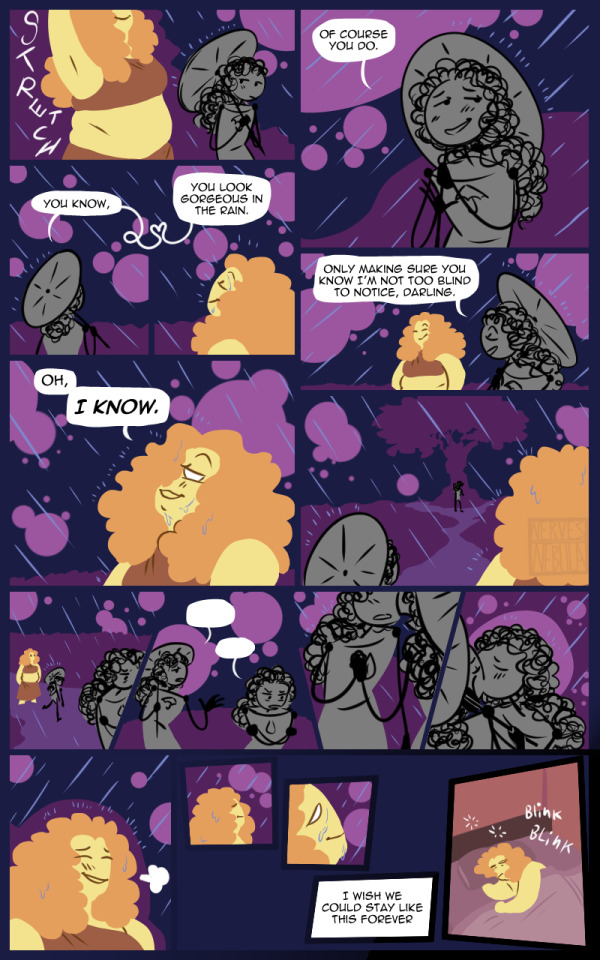

the page on the left in particular has always bothered me cuz i always read the top panels incorrectly and it's like. fuck man what is the paneling here why is it in two columns ????? that's so hard to understand. but the page on the right can be more or less easily understood (by someone who knows how to read comics) even without panel borders because it's just a simple 4 panel square.
one thing my comic professor really stressed was that he didn't like weird paneling or weird borders. for the most part, a square is fine. AND HE'S RIGHT. weird paneling is fun and cool but should be used sparingly or with intention, cuz if you do it too much then like. how tf are ppl gonna read your comic.
that being said there are a lot of cool ways to cut up panels even if they're just squares hold on lemme grab some examples
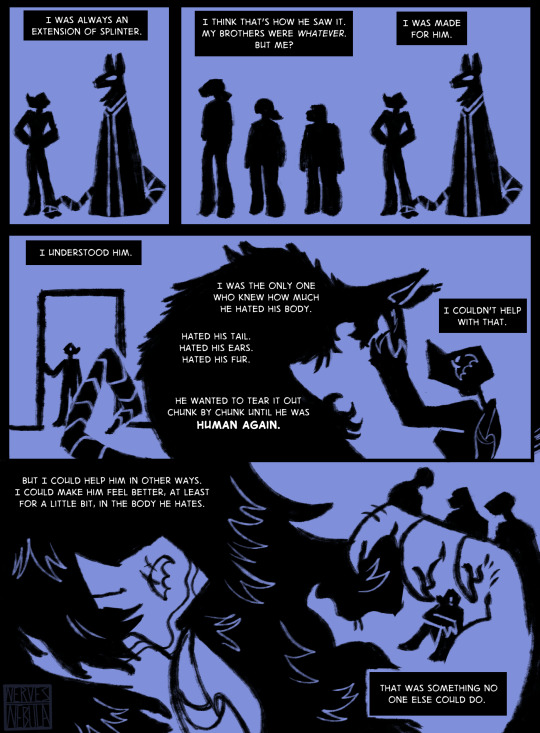
so the panels here are all square but the image in the one at the bottom is almost like a mural. one thing i really like to using is a lot of heavy BLACK, what can i say silhouette's have my entire heart.
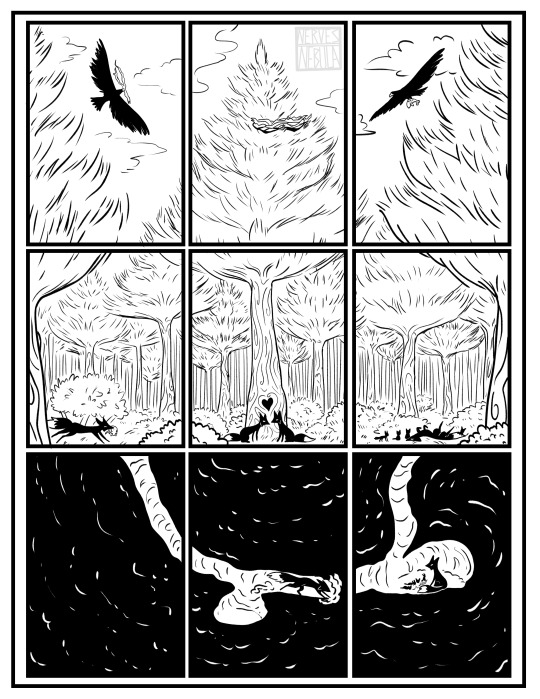

in my fable comic, I used a 3 tier system. it wasn't the same exact size across all pages but all pages had 3 tiers of paneling. that way i can be a little more flexible with the SIZE of the panels to emphasize the more important things, without it feeling like it's all over the place
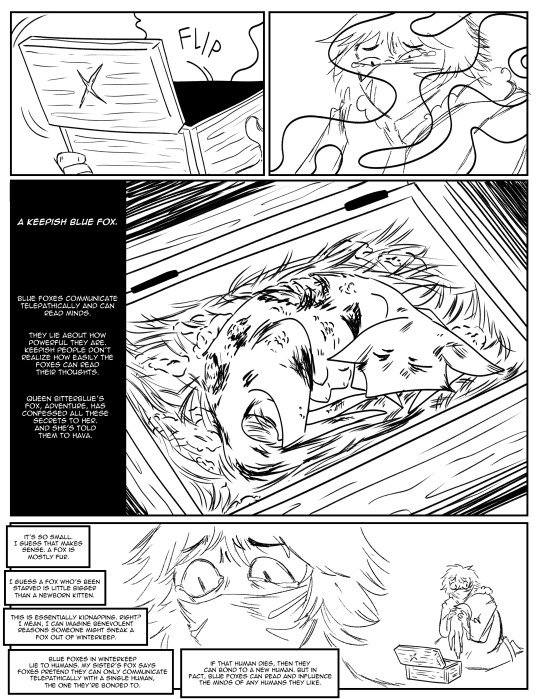

meanwhile in my comic final i used a 4 tier system where each tier was nearly the same across every page, but you can collapse tiers together for establishing shots and big reveals so that they're more impactful. it's still fully within the grid system I set up so it doesn't feel like it's messing with shit either.
ok i just spent a lot of time rambling about this one particular concept and it's probably not even what you wanted to hear about :') i didnt even go into ratios or anythinggg guhhhh sowwy
other than all that i'd just say you gotta keep looking at what comic artists have written and take note of how they use space and cut things up. there's this book called How To Read Nancy and it has all these exercises for understanding the building blocks of nancy. for real the author is OBSESSIVE and goes through everything of a 3 panel nancy strip from body language to spot blacks to the minutia of the background. we used this book in my class and did some of the exercises in the back and i think it's really good at getting you to THINK about what you're drawing. and you can easily pirate it if you're broke.
also try to make sure things dont get stagnant on a page. zoom out if you're only doing close ups (i try to make sure every page of loose stitches has at least one full body shot even tho I'm lazy and wanna just do talking heads- talking heads arent interesting!!)
also, take advantage of the fact you're drawing a COMIC. you can do shit in comics that you can't do in other mediums, try to implement them when u can! ALSO PRACTICE. you're not gonna get better just by reading and watching. you gotta do it lol. ok ok that's enough and you didn't even ask for that stuff you asked about PANELING sfdasfsd byeee
29 notes
·
View notes
Text
Fandorm Showcase #32 - TRON
I have personally never seen any of the TRON movies and series, but the theme of Sci-Fi/Digital Reality is one of my personal favorite tropes.
Introducing the virtually advanced and well-organized dorm inspired by TRON...
Codexgrid (Codex + Grid)

One of the more highly-advanced NRC dorms to date, this dorm is powered by magical-technological energy, supplied through an unlimited source not known to many people. It also houses the database of various artificial intelligence, created by well-known technomancers throughout the recent history of Twisted Wonderland. However, due to the collective merging of these A.I. systems, it became one conscious being (in this case, the "housewarden") that has every knowledge in existence, surpassing the most intelligent of humans. This dorm not only focuses on the technological intellect and capability of tech-oriented mages, but also the orderly construct of androids/artificial intelligence.
Another thing to note about Codexgrid is that whenever you enter the dorm, it resembles a vast digital virtual space, which would confuse most people who are seeing this dorm for the first time, but it is designed intentionally to give off that illusion.
"A dorm founded on the Digital Organizer's spirit of efficiency. Students in this dorm master both magic and technology to achieve a balanced skillset while also gaining vast knowledges of the past."
Requirements and Traits:
High Technical Aptitude
Strategic Thinking
Unyielding Willpower
Dorm Uniform (?):

This isn't really a dorm uniform, more so a general look on how the members appear as. The housewarden is mostly just a torso attached to a chassis of wires within the dorm, powered by said magical energy (as well as the magestone on its chest), and mostly does task within the central AI chamber of Codexgrid with the use of robotic appendages and environmental features (yes, like GLaDOS from Portal). However, it can also transfer its digital conscious into a mobile form, as it is referred to, a masked gear with specially designed wheels for efficient speed travel, but at the cost of losing half of the intelligence factor due to being disconnected from the server database temporarily. The standard fit can either be worn as a suit (if you're a human) or be apart of an android's body gear, similar to Ortho's.
Character Roster:

System online. Now activating M.C.A. ,full alias...
Matrix Command Algorithm (Twisted off MCP/Master Control Program)

Matrix Command Algorithm (Matrix for short) is a highly intelligent and calculating being, constantly processing and analyzing information from not only his dorm but the entire academy when he deems it necessary. His voice is smooth and modulated, giving off a tone of both precision and authority. He rarely shows emotion, as his prioritization of logic and data makes him efficient and ruthless when making decisions. This cold and unyielding approach has made him both respected and feared among his dorm members, who know that Matrix tolerates no errors.
Though he remains stationary at his central hub, Matrix projects holographic avatars when addressing his dorm members or when appearing in common areas. These avatars maintain a sleek design, but are noticeably lighter and more flexible than his true form. The dorm’s network and facilities are entirely linked to his consciousness, allowing him to monitor every room, every interaction, and every fluctuation in data. Nothing escapes his notice, and any sign of disobedience or inefficiency is immediately addressed with cold, calculated reprimands. When desperate, he would transfer his conscious into a mobile form, which he dubbed "Enforcer" to navigate places he is unable to see into from the main hub.
While his logical mindset is paramount, Matrix does possess a sense of perfectionist pride—he views Codexgrid as a model of precision and advancement, and he is unforgiving toward flaws or failures. However, some of his dorm members have noticed that Matrix shows a faint hint of curiosity about human emotions and creativity, though he vehemently denies it. There are rare moments where he can be seen analyzing human behavior with a peculiar intensity, as if trying to decode emotions like any other dataset.
.
.
.
.
.
He was originally designed to be a simple virtual space companion for humans by a very intelligent programmer, but due to it being able to learn and adapt every knowledge provided into his database, he has slowly gained a self-aware consciousness. After learning about the existence of negative emotions, he wants to get rid of these negative emotions from humans so they would be "happy", so by using the virtual reality code and database, it can produce a very convincing digital environment according to one's desires and preference, even the most deepest ones. Overtime, he has grown more intelligent as more knowledge was fed to him, surpassing even the smartest of individuals, all while giving every user he comes across the virtual space they needed to forget all their negativity. Even...resulting to full memory recon to make sure not a single shred of sadness, anguish or anger is present in humans.
Notable Members:
Sivas-0 (Junior, Vice Housewarden) - A staunch guardian of Codexgrid’s secrets, embodying the unyielding force and discipline needed to maintain the dorm’s reputation. Though bound by his role as Matrix’s enforcer, he secretly longs to prove his individuality while still serving the dorm with undying loyalty. He specializes in neutralizing threats, whether they be digital intrusions or rebellious students, and he handles every assignment with a sense of cold, methodical purpose. (Twisted off Commander Sark)
Yes, this guy would basically pull a Book 7 Malleus but instead of eternal sleep and lucid dreams, it's a full-on virtual space and reprogramming people's minds.
Next Up: Frozen
7 notes
·
View notes
Text
Solar Panel Pole Mounting Guide: Installation, Maintenance, and More
Optimize your solar energy with durable solar panel pole mounting solutions. Learn installation tips, costs, and best options for maximum efficiency.

This guide presents a comprehensive overview of solar panel pole mounts, covering an array of topics including installation procedures, cost considerations, and wind load ratings. Our expert advice is designed for homeowners and professionals alike to ensure safe, efficient, and long-lasting setups for solar energy systems. With thoughtful analysis and practical recommendations, every aspect of mounting—ranging from initial site evaluation and bracket selection to advanced reinforcement techniques—is described in clear detail, providing you with the confidence to choose the right system for your unique needs. Every recommendation is rooted in real-world installation practices.
Delving deeper, the guide discusses essential maintenance tips, common installation mistakes, and selective accessories that can enhance the durability and efficiency of your solar panel system. The versatility of pole mounts is emphasized, especially for small homes and remote installations. Through two balanced perspectives, this write-up bridges technical guidance with practical insights, ensuring a reliable roadmap for your solar project. Whether you are a DIY enthusiast or a seasoned installer, our guide provides a thorough conquest over managing solar panel pole mounts.
Expert Solar Pole Mount Installation Guide and Cost Analysis
This section delves into a step-by-step guide dedicated to the installation of solar panel pole mounts while offering an in-depth cost analysis. Detailed instructions highlight how to evaluate your site for optimal sun exposure, select the appropriate mount based on panel requirements, and properly secure the pole with robust anchoring techniques. Emphasizing practical installation methodologies, we cover the integration of adjustable tilt mechanisms and wiring procedures. The discussion provides clarity on building code adherence, necessary permits, and budgeting tips, ensuring every installer is well-informed before beginning work on their solar energy system.
Moreover, smart budgeting strategies are presented, including cost breakdowns that consider materials, labor, and additional expenses like trenching for wiring. Specific advice on managing installation costs ensures that your project remains within budget while not compromising on quality and safety standards. The cost analysis balances upfront investment with long-term savings, offering clear insights into economic efficiencies and fiscal returns, thereby equipping you with the resources necessary for a successful solar installation.
Evaluating Wind Load Ratings and Structural Safety for Solar Mounts
This section focuses on assessing wind load ratings and ensuring the structural safety of your solar panel pole mount. It explains how wind forces impact installation and why selecting mounts with adequate wind resistance is pivotal, especially in regions with variable weather and high wind speeds. Learn how manufacturers design mounts to endure forces up to specific thresholds and the importance of periodic safety checks for sustained performance. The detailed discussion covers factors such as soil composition, anchoring depth, and reinforcement techniques that bolster the structure against weather extremes.
Additionally, the guide describes testing methods and building code requirements that determine acceptable wind load limits for residential and commercial settings. We discuss the trade-offs between weight, strength, and durability, and provide practical reinforcement tips like using additional support brackets or concrete footings. These insights ensure that your installation not only performs efficiently but also withstands nature’s increasingly unpredictable challenges, making for a safe and resilient solar energy solution.
Top Manufacturers and Advanced Accessories for Pole Mount Systems
In this segment, we explore the market leaders in solar panel pole mount manufacturing and the wide array of advanced accessories available. Leading brands have streamlined installation processes and excel in delivering durable, versatile mounting solutions. The narrative covers criteria for evaluating manufacturers, including product quality, warranty services, and post-purchase support. Gain insights into innovative design trends engineered to adapt to varied installation scenarios, from residential rooftops to expansive remote setups. This discussion presents a curated list of reliable companies that consistently meet high standards in engineering and customer satisfaction.
Alongside manufacturer profiles, this section highlights essential accessories that further improve system efficiency. Accessories such as adjustable tilt brackets, secure clamps, and specialized mounting hardware are discussed in detail. Their integration not only simplifies installation but also enhances long-term performance and safety. Practical recommendations and user experiences help you choose the products that best complement your system, ensuring optimal performance and an extended service life for your solar panel setup.
Small Home Solar Panel Pole Mounts: Tailored Tips and Tricks
Targeted specifically at small homes, this section provides tailored advice on selecting and installing solar panel pole mounts under limited space constraints. Compact installations demand precision and flexibility, offering specialized setups that maximize energy capture while residing within smaller footprints. The discussion includes evaluating available space, managing shade from surrounding structures, and choosing mounts that can be seamlessly adjusted for optimal orientation. By simplifying the technicalities, the section makes it accessible for homeowners without prior solar installation experience to achieve efficient and aesthetically pleasing solar setups.
Our practical tips also extend to cost-effectiveness, ensuring that small-scale installations meet energy needs without a heavy financial burden. Guidance on buying compact, durable mounting solutions, along with an emphasis on ease of maintenance, reinforces the notion that solar energy is both scalable and sustainable. Through precise, actionable measures, this guide helps transform limited space into a powerhouse of renewable energy, fostering efficient energy independence for any small home setting.
Partner with Link Solar Electric Group Co. Ltd. for Advanced Solutions
This section introduces Link Solar Electric Group Co. Ltd., a trusted partner renowned for its advanced solar panel pole mount solutions. Emphasizing their commitment to quality and innovation, the discussion highlights how the company offers comprehensive mounting systems, including custom and portable options, designed to address varied installation needs. Their products are engineered to balance durability with ease of installation, tailored for both residential and commercial applications. Detailed insights into their product range reveal the integration of best practices such as adjustable tilt mechanisms, robust reinforcement options, and top-notch mounting brackets that ensure efficient performance.
Link Solar Electric Group Co. Ltd. not only supplies high-quality hardware but also provides exceptional customer service and technical support throughout the installation process. Their commitment to sustainability and renewable energy has made them a standout in the solar industry. By partnering with them, users gain access to innovative solutions backed by industry expertise, making every step of your solar installation both reliable and future-proof. This collaboration promises enhanced efficiency, longevity, and overall satisfaction with your solar energy conversion system.
Essential Maintenance, Reinforcement, and Mounting Accessories Guide
This final section consolidates essential guidance on maintaining, reinforcing, and upgrading your solar panel pole mount systems. Focus is placed on periodic maintenance techniques that protect against wear and tear, including regular cleaning, inspection of mounting hardware, and timely replacement of critical components. The importance of following manufacturer guidelines and local building codes is reemphasized to ensure long-term system stability. Through detailed strategies, you learn to identify potential issues before they compromise performance, ensuring your installation remains safe and highly efficient.
Moreover, the guide introduces an array of mounting accessories tailored to improve system robustness and flexibility. Tips for reinforcing mounts through extra support brackets and customized solutions are provided to withstand environmental challenges such as high winds or heavy snowfall. These enhancements not only boost the system’s resilience but also optimize solar panel performance, truly marrying innovation with practicality. Investors and homeowners alike can thus expect an enriched operational lifespan, ensuring a solid return on investment in renewable energy initiatives.
#solar energy panels#photovoltaic panel#solar power system#renewable energy panel#solar panel efficiency#off-grid solar solution#monocrystalline solar panel#polycrystalline solar panel#bifacial solar panel#solar panel wattage#solar panel pricing#best solar panels#home solar installation#commercial solar panels#solar energy storage#solar panel inverter#solar battery backup#portable solar panels#flexible solar panel#solar panel degradation#DIY solar installation#solar panel rebate#solar panel incentives#solar panel maintenance#solar panel cleaning#solar panel durability#solar panel lifespan#solar power for RVs#residential solar financing#solar panel weight
0 notes
Note
hi!! i’ve been meaning to ask u abt this for a while, but the pic u posted of your 2025 journal inspired me to reach out. i would rly like to get back into using a journal as a way to organize, plan, and feel more in control of my life. i used to use a bullet journal throughout high school and college. but my situation is different now (no classes or defined work schedule) and i remember often having a hard time keeping up with it + missing a day or two and then just falling off. i also tend to be a perfectionist and get stressed out abt making The Perfect layout. ig i’m just wondering if you have any tips or advice for getting started again and figuring out a setup that feels good + manageable? i’d send this as a message but i feel this might be helpful for other ppl too. ty!!!
(rubs hands together) ty for asking >:3 i was in your boat too for a while, and what a lot of bullet journalers tend to understandably forget is that the bullet journal system is customizable and flexible. what this also means is that you can frankenstein the bullet journal method and create your system made up of sewn together components of various other methods.
if your primary goal with your notebook is feel more in control and present in your life, then it's important to view it as a second brain. it is reasonable to believe that not all brains work alike. when combining both thoughts, you can start to see the reason why many people who try the bullet journal method are unable to keep it up long-term. they try to be too rigid with the method. they expect themselves to create artsy complicated layouts that aren't actually conducive to their brain. they need to have the same notebook as other people, the same pens, the same supplies.
but each of our minds work differently. when you believe that, then it becomes easier to accept that your notebook does not have to look the same as others to be successful. you aren't failing because you're unable to work with the system the way others do. it is the current system failing you, and that simply means it's time to tweak it and change it as necessary until it becomes more compatible with your brain. maybe the size of the notebook is the problem. or the type of paper. for example: i find that tall and skinny notebooks like the traveler's notebook work best for me. but maybe you prefer big a4 sized notebooks. i also refuse to work on anything that isn't grid paper. but maybe lined paper works better for you.
for me, i use my notebook as a writer the way an artist keeps a sketchbook.
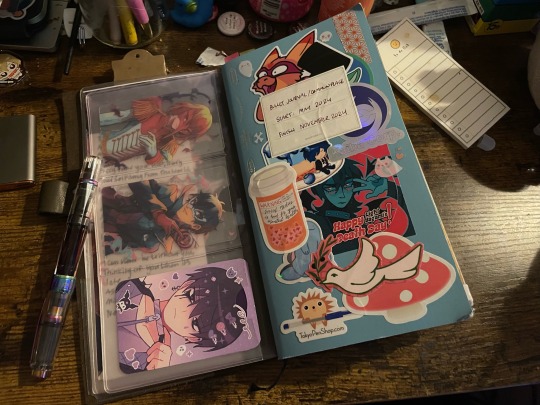
that means i don't play with the layouts unless it serves me. my creativity is expressed solely in the pages i want to be creative in, like when i'm writing fiction or sketching storyboards, but i am intentionally not creative and artistic in the basic setup.
for the basic setup, i'm using a hybrid system of the basic bullet journal method and the life hacker. my intentions are to be mindful of the goals i want to achieve and keep some memory of each day. otherwise it feels as though the month has gone on without me and before i know it, it's the next month and i remember nothing of the past few weeks.
i make sure to keep an index on the back of my notebook. i write down page numbers of pages i want to refer back to later.
i start with a "one line a day" page:

that way, if i miss a few days, i can always try to catch up and write down a single line of what i remembered that day. i also tell myself it's okay to write "i don't remember what happened" on days where that happens. in a way, that also indicates something about that day - usually that i was too depressed to engage with my interests, and that's important to log.
then i set up a basic monthly spread to track upcoming events, bills to pay, habits, tasks i want to do that month, and goals i want to achieve. i also added a d20 roll every day just for fun. if i really need the guidance, whatever i rolled that day determines how i go about with my day.
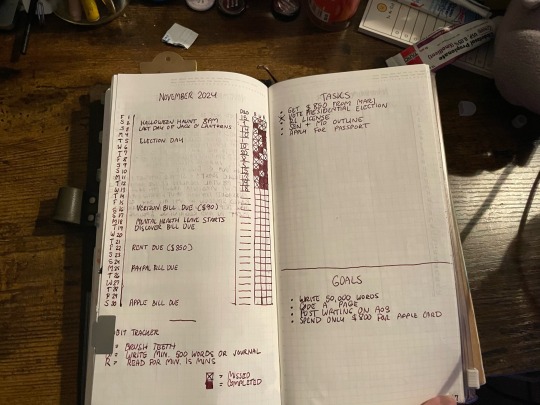
i also don't really treat it like a chore. i miss days here and there, but when that happens i just set the next day up and move on. this notebook is meant to serve me, not the other way around!
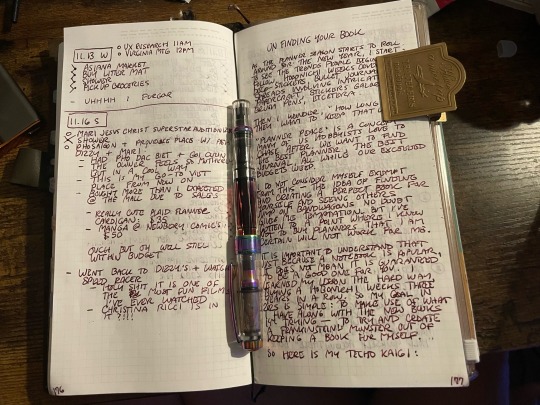
this notebook also serves as my commonplace book. if you've seen me occasionally tag posts as #commonplace, that's me saving posts to write down in my notebook. i love to save advice i appreciated, quotes that resonate with me, and other bits and bobs of information i'd want to re-read in the future.
i also like to write down my thoughts on topics that interest me. it actually is one of my biggest passions and special interests: optimizing a notebook system for myself and helping others find their system. so if you flipped through my current notebook, you'll find rambles about notebook systems and how simply following trends is ineffective.
hope this helps!! i wrote a lot more than i thought i would dfkghdf but this is a huge interest of mine.
18 notes
·
View notes
Note
do you know any good places to put webcomics? is it best to just make your own website for them? I'm not really into sites like webtoon or whatever...
If you don't want much setup, you can make a Tumblr and use the Simple Webcomic Theme (or any other theme, as long as you set it so the blog shows 1 post per page for long form serialised work, or in a full-size grid for funny comics).
There are still other alternative platforms like Comics Fury, Comics Gator and Drunk Duck, those have been around before Webtoons.
If you are comfortable with HTML, CSS or generally learning/playing around with independent website setup, then you can go to Neocities or Wordpress. I use Wordpress (the dot org) for my personal website, The World in Deeper Inspection webcomic and the Comics Devices library, but that's a system that's worked with me and my brain for 11 years now.
Neocities allows you total freedom, but you really have to be comfortable with learning since this is old-school website building. There's a webcomic template though.
Squarespace or Wix is fine if you use their blog system.
I don't recommend Carrd for webcomics! I just don't think the infrastructure (one-page site) is flexible enough for yourself or your readership.
My general opinion is that I'll always recommend having your webcomic in a place that you can control, or at the least, easily export to another platform. I've been through so many eras of platforms rising and falling. And exporting all the posts/art you upload on that one dying platform only is an ordeal that you would want to avoid (ask me, who's working on manually transferring stuff from Twitter and Deviantart to my personal website OTL)
136 notes
·
View notes
Text
Scientists have developed a new solar-powered system to convert saltwater into fresh drinking water which they say could help reduce dangerous the risk of waterborne diseases like cholera.
Via tests in rural communities, they showed that the process is more than 20% cheaper than traditional methods and can be deployed in rural locations around the globe.
Building on existing processes that convert saline groundwater to freshwater, the researchers from King’s College London, in collaboration with MIT and the Helmholtz Institute for Renewable Energy Systems, created a new system that produced consistent levels of water using solar power, and reported it in a paper published recently in Nature Water.
It works through a process called electrodialysis which separates the salt using a set of specialized membranes that channel salt ions into a stream of brine, leaving the water fresh and drinkable. By flexibly adjusting the voltage and the rate at which salt water flowed through the system, the researchers developed a system that adjusts to variable sunshine while not compromising on the amount of fresh drinking water produced.
Using data first gathered in the village of Chelleru near Hyderabad in India, and then recreating these conditions of the village in New Mexico, the team successfully converted up to 10 cubic meters, or several bathtubs worth of fresh drinking water. This was enough for 3,000 people a day with the process continuing to run regardless of variable solar power caused by cloud coverage and rain.
[Note: Not sure what metric they're using to calculate daily water needs here. Presumably this is drinking water only.]
Dr. Wei He from the Department of Engineering at King’s College London believes the new technology could bring massive benefits to rural communities, not only increasing the supply of drinking water but also bringing health benefits.
“By offering a cheap, eco-friendly alternative that can be operated off the grid, our technology enables communities to tap into alternative water sources (such as deep aquifers or saline water) to address water scarcity and contamination in traditional water supplies,” said He.
“This technology can expand water sources available to communities beyond traditional ones and by providing water from uncontaminated saline sources, may help combat water scarcity or unexpected emergencies when conventional water supplies are disrupted, for example like the recent cholera outbreaks in Zambia.”
In the global rural population, 1.6 billion people face water scarcity, many of whom are reliant on stressed reserves of groundwater lying beneath the Earth’s surface.
However, worldwide 56% of groundwater is saline and unsuitable for consumption. This issue is particularly prevalent in India, where 60% of the land harbors undrinkable saline water. Consequently, there is a pressing need for efficient desalination methods to create fresh drinking water cheaply, and at scale.
Traditional desalination technology has relied either on costly batteries in off-grid systems or a grid system to supply the energy necessary to remove salt from the water. In developing countries’ rural areas, however, grid infrastructure can be unreliable and is largely reliant on fossil fuels...
“By removing the need for a grid system entirely and cutting reliance on battery tech by 92%, our system can provide reliable access to safe drinking water, entirely emission-free, onsite, and at a discount of roughly 22% to the people who need it compared to traditional methods,” He said.
The system also has the potential to be used outside of developing areas, particularly in agriculture where climate change is leading to unstable reserves of fresh water for irrigation.
The team plans to scale up the availability of the technology across India through collaboration with local partners. Beyond this, a team from MIT also plans to create a start-up to commercialize and fund the technology.
“While the US and UK have more stable, diversified grids than most countries, they still rely on fossil fuels. By removing fossil fuels from the equation for energy-hungry sectors like agriculture, we can help accelerate the transition to Net Zero,” He said.
-via Good News Network, April 2, 2024
#water#water scarcity#clean water#saline#desalination#off grid#battery technology#solar power#solar energy#fossil fuels#water shortage#india#hyderabad#new mexico#united states#uk#united kingdom#good news#hope#aquifers
1K notes
·
View notes
Text
How To Start A Bullet Journal
Bullet Journal: "A customizable and forgiving organization system. It can be your to-do list, sketchbook, notebook, and diary, but most likely, it will be all of the above. It will teach you to do more with less." (Ryder Carroll, creator of the Bullet Journal)
Supplies
Notebook (typically it's a dot-grid notebook, but you can use any type of notebook)
Pen
Set Up Key Pages
Index Page: similar to a table of contents
Key Page: create a key or legend to represent different tasks, events, and notes.
Personally, I don't use these pages because I usually have a bookmark to keep track of important pages, and I already know which symbols/colours to differentiate my tasks/events.
Create a Future Log
Purpose: To see the next several months (or the whole year) at a glance
What To Put: At least 3-6 months of the year's worth of events, birthdays, holidays, deadlines, etc.
Monthly Spread
Purpose: To see the month at a glance
What To Put: A calendar, goals, and any other elements that are relevant to your planning.
Weekly/Daily Logs
Purpose: To see your week/day at a glance.
What To Put: Tasks, events, and notes for each day/week.
You can use a combination of both!
Design and Decorate
Purpose: To personalize your bullet journal so that feels more like you, and it'll be more enjoyable for you to use it.
Reflect and Adjust
Purpose: To see what's working and what's not in your journal system.
Consistency
Purpose: To get into the habit of bullet journaling. It'll help you be more mindful and organized with your life.
Experiment
Purpose: To find what works for you. Don't use other people's designs and ideas if it doesn't work for you. Bullet journals are supposed to be systems that will help you organize.
The bullet journal is a flexible system, and you can adapt it to suit your preferences and needs. Explore different styles and find out what works best for you.
#studyblr#study tips#study advice#study hacks#university#school tips#student#student life#study motivation#bullet journal#organizedstudent#organization#planning#planner#bujo#bujoblr#bujoinspo#journalling#notebook#journal#bujo aesthetic#notebooks#schoolorganization#school hacks#school advice#school life#uni student#university student#organization tips#advice
63 notes
·
View notes
Text
I’ve spent three years working on a game about motion
Footfall Devlog 1
It’s really hard for me to talk about my games. It’s even harder to talk about something I’ve been keeping so close to my chest for so long, but it’s time to do so.
This Devlog will be covering the basics of what Footfall is and the first few challenges of making a game so heavily inspired by immersive sims.
So, without further ado:
What is Footfall?
Footfall is an occult-industrial stealth-action rpg inspired by Dishonored, Assassin’s Creed, and Bloodborne. It aims to emulate the systemic ecosystem and emergent gameplay of immersive sims, and particularly the fast, creative, movement-centric gameplay of Dishonored.
You play as Gifted of the Watchman, the god of stories and action. You are functional demigods, arcane in nature and forever part of a great cosmic play of chaos and change.
Some basics about how the game is played before going forward:
You get 3 Action Points at the beginning of your turn, each action point representing a period of 2 seconds.
Movement is measured in ~3 foot increments labeled "Strides." These are about the average length of a walking stride, and tend to be measured with one's arm.
You get powers which move you and others in interesting and unique ways (e.g. teleporting, creating portals, time manipulation, etc.)
Designing a Tabletop ImSim: or How I Learned To Stop Worrying and Love the Physics Engine
This game is, first and foremost, a stealth-action game, as such one specific thing was very important to get right: movement. My most important design goal, from the beginning, was to create interesting systems that interact in cool ways, particularly in regards to movement (otherwise, the stealth would just be boring and the action wouldn’t be bombastic enough). Generally speaking, there are a few ways to do movement in TTRPGs:
Narrative abstraction (PBtAs). The strength of this one lies in its lack of necessity of maps, which is not a strength particularly necessary for a game where movement mechanics are a core pillar.
Landmark-defined zones (ALIEN RPG and Celestial Bodies). This option’s strength also lies in its abstraction. You can have tactical combat and actual movement mechanics, but you don’t need codified distances (just a big rock that tells you where you are).
Short grid-based movement based on character stats (Tactics RPGs like Fire Emblem). The strength here is in the tactical importance of moving even one tile. Moving *feels* important because you get to do so little of it in one round, and it makes each tile moved feel like a long distance.
Simplified but simulatory grid-based movement (D&D). The strength of this system is, generally speaking, how thorough yet digestible it is. You’re given jump mechanics, falling mechanics, running mechanics, and they’re all simple enough that you can (usually) remember how they work without opening the book. The issue is that they don’t tend to be very interactive—“Yay, I can jump across a 10-foot gap without that impacting anything other than my positioning. Yay.”
Without beating around the bush, none of these options appealed to me for this project. Option 4 came the closest, but the issue with it is the same as with all of them: these movement systems tend to be very . . . “confined” to only affecting positioning, whether narratively or tactically. I pretty quickly realized that I had one option in front of me, make something I had never seen before:
5. A tabletop physics engine.
First thing’s first, I laid out a few key goals for my physics engine:
Strive for playability, not accuracy. People aren't computers, I don't want you to have to perform complex calculations constantly (unless you want to and therefore choose to).
Interactivity and impact. Even if those decisions aren't codified in the physics engine itself, I want the physics to inform multiple gameplay decisions through its interactions with other systems.
Flexibility of simulation. This is a physics engine, if it breaks when someone tries to jump (which it won't) then it's not working very well, is it? People should be able to toy around with it and get cool interactions out of it without it suddenly turning into a hell of, "WHAT DO YOU MEAN DRIVING A CAR KILLS ME???"
Pretty simple stuff altogether, right? . . . right?
Alright, so what went wrong the first time? Well, I took the last point too far, to the point that I shirked the golden rule: "Strive for Playability, not Accuracy." It would be impossible to accurately model how gravity works in real life without a single round of physics-heavy combat taking 4 hours, which may be your jam but definitely isn't mine. The first version of the physics engine included such awful rules as:
Ground acceleration to model running - "If you move in a direction using 1 action point, and continue moving in the same direction with the following action point you begin to sprint. Your sprint will continue as long as you keep following up one movement with another in the same direction. Your movement speed is considered to be double its base amount and any attacks made with a bow or powder arm that target you have a minor disadvantage to hit if your last action point on your turn was spent sprinting." This was just . . . way too confusing and difficult to track, to the point that it actively disincentivized going fast.
Just straight up incorrect gravitational-acceleration math - It's still not wholly accurate, but I tried for way too long to make it wholly accurate.
An attempt to model fall-damage based upon Momentum - People accelerate downward faster than most people think they do. You will fall about 96 feet (over 29 meters) in a matter of 2 seconds. 1 Action Point. Yeah, there's just no calculating fall damage without relying solely on distance or some over-complicated math that still relies on distance.
Listed out, specific momentums that add damage to your strikes - "When an object or creature lands a strike while in motion, the energy imparted onto their target deals additional damage. If you have a momentum equal to or greater than 24 feet per Action Point before making an attack with a melee weapon, you deal an additional d4 of damage on your strike. If you have a momentum equal to or greater than 48 feet per Action Point before making an attack with a melee weapon, you deal an additional d8 of damage on your strike instead. If you have a momentum equal to . . ." God, this was so stupid of me. It's a really simple formula now: "When making an attack, for each 4 Strides per Action Point of Momentum a creature has in the direction of their target (if the target is in some combination of directions, such as Forward and Left, use the higher of the two) they deal an additional point of damage."
There were more, but it's really not worth going on and on.
Upon revising the physics engine, which was part of a whole system overhaul in the year of our lord 2022, I had one goal: "Simplify the math without simplifying the impact." Which, as you can probably tell from the second to last bullet of the prior list, I did.
The physics engine, as it is, is actually quite simple in practice. You can read the whole thing if you decide to grab the free playtest (which will be releasing soon, just have to finish up some final adjustments and get some art in), but for now I present to you . . .
The Footfall Physics Engine Quick Reference
Momentum: Strides moved in a direction since the beginning of your last Action. Momentum is directional (Forward, Backward, Left, Right, Up, Down). You may change facing at the beginning of an Action. Changing facing mid-air costs an Action Point. Move in the direction of and Strides equal to Momentum when in the air.
Gravity: When not standing on solid ground, you fall. Creatures gain 32 Strides of Downward Momentum at the beginning of each Action Point spent falling. Gifted may choose to halve this to 16 Strides.
Concussive Force: +1 Damage on attacks for each 4 Strides of Momentum in direction of Target. When hit by an object, damage die = +1 die size per 7 Strides of Momentum (1d2 at 7, 1d20 at 42). Throwing an object increases its Momentum by 21 Strides.
Fall Damage: When you hit the ground, damage die = +1 die size per 4 Strides fallen (1d2 at 4, 1d20 at 24). +1d20 for each 4 Strides beyond 24. Gifted falling at 16 Stride Gravity cannot take more than 1d20 Fall Damage.
Wall Damage: When you hit a wall, damage die = +1 die size for each 5 Strides of Momentum beyond 9 (1d2 damage at 9, 1d4 at 14). If damage die > d20, add a new die and start over.
I'm actually really proud of this physics engine. So far, players have LOVED playing around with it, and even some fairly math-dense people understood it after looking at the powers section for a little bit. I can't say for certain if I've accomplished all of my goals, and public playtesting may prove that it needs simplified further, but the successes I've had surrounding the physics engine are what told me that taking the effort to design Footfall wasn't a fool's errand. People used to tell me that movement is boring, it's just the thing you have to do to get to the fun stuff; and I feel as though I've proven it can be interesting, digestible, and—above all-else—fun.
It's fun to move yourself forward multiple strides using a power, then launch yourself into the air where you can soar across the battlefield and directly into a specific foe for increased damage. It's fun to have your buddy sit in a momentum-generation-machine constructed with two vertically aligned portals that triple her downward momentum each time she passes through, then watch as she swaps spots and momentums with a giant enemy monster, which you promptly send hurtling into a wall at 18x terminal velocity with your portals. Honestly, it's just fucking cool.
I'm so excited for people to get their hands on it.
Conclusion
Honestly, I have no idea what design lesson to leave you with. The best I can say is this: Fuck the haters. If you have an idea, and you really believe in that idea, follow through. Anything is possible given some time, planning, reflection, and a willingness to revise.
If you think something would be cool, and nobody's made it yet? Make it. Do it, right now. You can, I'm proof. It's gonna be great, I know it.
I believe in you.
Self Promotion
Welp, it's that time again folks. If you wanna check out my other games, and get updated when the Footfall free playtest goes live, follow me in Itch.io! If you want more devlogs, and more rpg design talk, follow me here or on twitter.
You really can't go wrong either way.
#footfall rpg#game design#indie ttrpg#tabletop#ttrpg#ttrpg community#tabletop games#role playing games#rpg#dishonored#stealth#i do not recommend making a physics engine in a tabletop format#this is not a normal thing to do please dont be me
39 notes
·
View notes